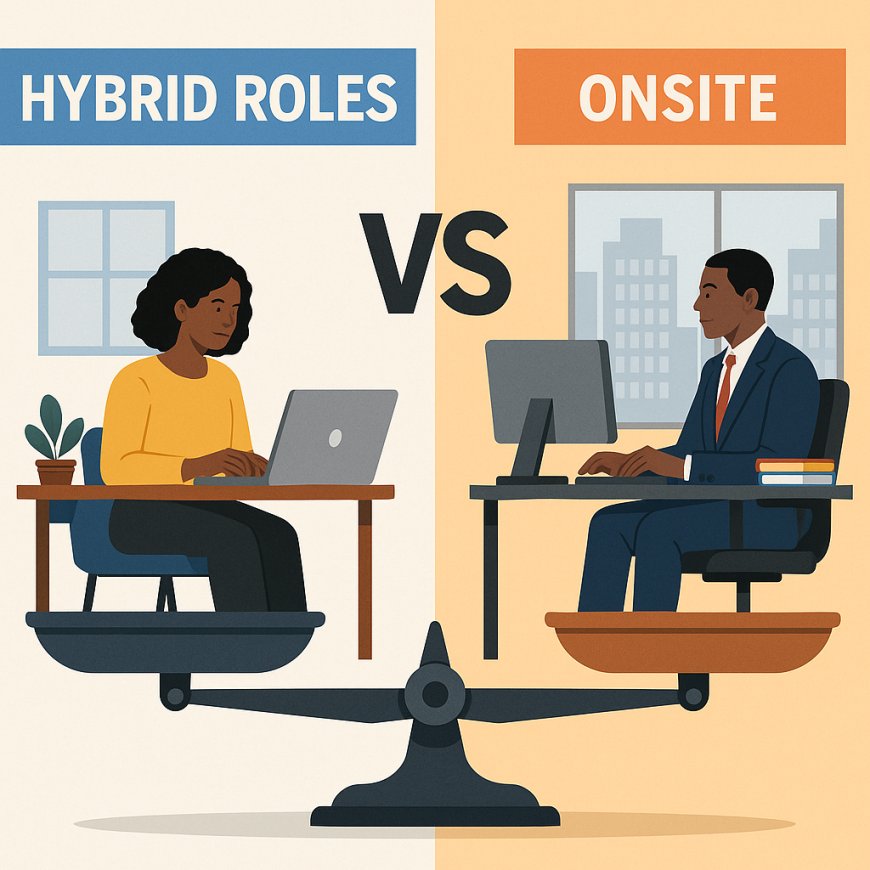HYBRID ROLES VS ONSITE: WHICH ONE IS BETTER?
Is hybrid work better than onsite roles? Explore the benefits and challenges of each work model to decide which best suits your productivity, lifestyle, and goals.

The global COVID-19 pandemic changed the nature of work on a large scale. The traditional mode of resuming at a physical office every weekday shifted to a new remote mode in many organizations.
Hybrid roles are those that combine the onsite and remote forms of work. In other words, the employee spends some days at the office and other days working remotely. This hybrid model is becoming more popular all over the world, including in Nigeria. As its popularity and adoption grows, the relevance and benefit of onsite roles are called into question.
In this article, we will explore the nuanced sides of both and establish if one mode is superior to the other.
Onsite roles involve daily attendance of workers at a physical workspace, with fixed resumption and closing times. In contrast, hybrid roles are more flexible, combining onsite work with remote work, i.e., work done without having to resume at the physical office. Both work models have significant benefits and challenges that are unique to each.
For many workers, hybrid roles are a more attractive option. Those who live in urban areas cope with the stress that comes with commuting to and from work every day, which includes traffic, high transportation costs, and unpleasant experiences. Hybrid roles reduce the time, energy, and cash spent on transportation to work. This contributes to better physical and mental health outcomes.
In addition, hybrid roles allow for a better work-life balance. Workers can spend more time with their families and be present, without letting their work suffer. There is also increased satisfaction because people who prefer to work independently have more space to do so and can manage their time more efficiently.
In spite of these benefits, hybrid roles bring some unique challenges. Power supply and internet connectivity, if inconsistent, can seriously affect performance and productivity. These also demand higher costs spent on maintaining them, either by purchasing fuel, solar panels, inverters, wi-fi subscriptions, or data bundles.
Hybrid work may not always lead to higher productivity. People who live in homes where distractions are many may have a difficult time staying focused on their tasks. Also, not everyone has the self-discipline to work in an environment with little physical supervision. Such individuals may find it difficult to perform their tasks efficiently.
For reasons such as these, many organizations still maintain onsite roles. A physical office provides structure, supervision, and a clear distinction between work and personal life. There is face-to-face interaction, which fosters community building and promotes accountability. Onsite roles also offer the opportunity to learn by observation, easily network, and be mentored.
Onsite roles contribute to higher productivity by providing quality infrastructure needed to work, such as electricity and internet connection. Furthermore, there are roles that demand being physically present, such as security guards, facility managers, and some healthcare roles. Hybrid work would not be feasible for such positions.
The disadvantages of onsite roles are familiar. The stress involved in commuting to work daily can be physically and mentally draining, often leading to fatigue and lower worker morale. High costs of transportation due to rising fuel prices reduce the proportion of income that can be spent on other essentials.
The lack of flexibility associated with onsite roles can result in less time spent on personal and family activities. Self-care may also be neglected and unhealthy eating or sleeping patterns may emerge. The burden of managing the stress that comes from onsite work can make this work model feel like a “rat race”, a term that is popularly used.
Given the nuanced nature of both roles, it is clear that neither work model is outrightly better than the other.
The decision to choose one over the other should be based on factors including personal work style, the living situation, and the role responsibilities. Are you highly independent and can you deliver great work without supervision? Can your job be done without you being physically present? Do you have the space and infrastructure at home (or elsewhere) to efficiently carry out your tasks? If yes, then hybrid roles may be right for you.
Do you prefer to work in structured and hands-on environments? Does your job require you to be physically present? Do you thrive in environments where you can easily connect and interact with people and build relationships? If yes, then you may be better suited for onsite roles.
The real question is not which mode is better. Rather, it is which one will best support your growth and productivity as a worker. For some people, hybrid roles will grant them the independence and autonomy they need to do their best work. For others, the structure and face-to-face relationships provided by onsite roles will help them thrive.
Ultimately, for organizations and workers alike, what matters is not where the job is done. What matters is how workers are empowered to contribute and add value to meaningful work, while enabling high job satisfaction and a deep sense of fulfillment.







